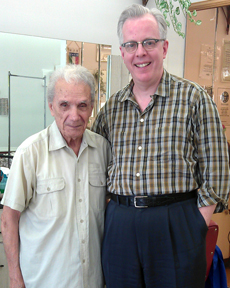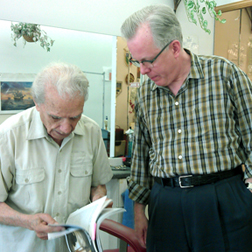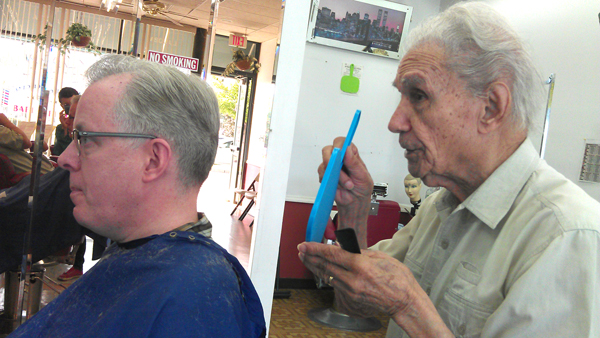Read about our most recent visit with Anthony, who’s now 107!
 Our father, a healthy and vital man of 83 years, was born in 1929.
Our father, a healthy and vital man of 83 years, was born in 1929.
Five years before that, Anthony Mancinelli started cutting hair for a living—and he’s still going strong.
When we learned that there was a 101-year-old barber still cutting hair just an hour or so north of New York City, we resolved to avail ourselves of his services sooner than later (after all, the guy’s 101—we’d have to be a sap to wait terribly long).
Thankfully, Ms. Cladrite was slated to run her first marathon a couple of weeks back in Portland, Maine, and since we were driving up in a rental car, we left a little early in order to make a slight detour toward Antonio & Pasquale Barber Shop in Vails Gate, NY, where Anthony plies his trade.
We lucked out and found Anthony at the ready upon our arrival. We sat down and he didn’t even bother to ask what we were looking to have done. He began by critiquing our current coif, pointing out with emphasis that the barber we usually patronize doesn’t do right by us, in that he doesn’t taper our hair enough on the sides (sorry, Cesar—he said it; we didn’t!) and then jumped right in, scissors a-snipping.
You wouldn’t believe for a moment if you didn’t know it to be true that Anthony’s age has reached triple digits. He seems no older than 80 and perhaps even younger; only his hearing seemed dimmed by the years—we found we had to repeat ourselves fairly frequently. But we didn’t mind, and Anthony was an engaging enough conversationalist that we were perfectly content listening more than talking—that’s why we were there.
Anthony reminisced about his childhood in Italy. His family lived 60 miles outside Naples, where his grandfather had a farm. Longevity, it seems, runs in the family, as his grandfather lived to be 103 and only died then because he fell off a ladder (he was harvesting something we couldn’t make out—olives? apples? not sure—from the upper branches of a tree and lost his balance).
Anthony said he and his young pals were paid to stamp about on recently harvested wheat to help remove the chaff and also to stomp on grapes with their bare feet at a local winery. He spoke fondly of being allowed to eat his fill of grapes while doing so. Anthony also held forth on the current state of bread—the problem with it, he said, is that wheat germ is now removed during the milling process to be sold separately. When it’s left in, as it was in the old days, bread stays much more moist and lasts much longer. We can’t vouch for his theory, but he spoke it with conviction, so we were willing to take him at his word.
Anthony came to the United States at the age of nine, and it was only three years later that he began barbering. He said he’s lived so long because he was always prepared to work hard. “When I was young,” he said, speaking of his early years in the U.S., “I got up at five in the morning to deliver papers. Then I went to school, and after school, I delivered more papers. Then I went to the shop to get more barber training, and when I was through with that, it was time for bed. I’ve always worked hard.” And we were convinced.
We asked Anthony how often, back when he was a young barber in the 1920s and ’30s, the average fellow came in for a haircut. “Most of them, every two weeks or so,” he said (that pleased us, because that’s our general approach, too). “Some of the older guys, every three or four weeks. But usually two weeks.”
Anthony also reminisced about the ancillary services a barber offered in the 1920s. Anthony burned off warts and performed blood-letting (with leeches, no less), cupping, and singeing. This last is a service we’ve heard referred to in old movies, but had never totally understood. Anthony took a stab at explaining it, though we’re still not sure we get it. Basically, he said that the theory back then was the hair is a living part of the body, even to the extent of bleeding when it was cut (Anthony insisted that he could demonstrate this “bleeding” if he were to rub my hair on a napkin or paper towel while trimming it, but he didn’t remember to follow through.) Anyway, the idea of singeing is to seal off the trimmed ends of your hair to limit the damage. It’s done with an open flame, but exactly what the process is, we’re not entirely sure. It’s not a service Anthony is asked to perform any more (though he insisted he still could do it—he did it with some frequency into the 1980s, he said).
 Anthony’s not a terribly well-kept secret. There have been print and film profiles of him in such prominent media outlets as the New York Times, the Voice of America, the BBC, Guideposts magazine, and, believe it or not, Al Jazeera. During our visit, Anthony seemed especially proud of a profile that appeared in a Russian magazine. He showed us the photographs that accompanied that story two or three times.
Anthony’s not a terribly well-kept secret. There have been print and film profiles of him in such prominent media outlets as the New York Times, the Voice of America, the BBC, Guideposts magazine, and, believe it or not, Al Jazeera. During our visit, Anthony seemed especially proud of a profile that appeared in a Russian magazine. He showed us the photographs that accompanied that story two or three times.
Our 45 minutes or so in Anthony’s company flew by. If he were within closer striking distance of us, we’d patronize him regularly; the haircut was that good. We were grateful to have had the opportunity to enjoy the tonsorial ministrations of the world’s oldest barber—that he proved to be a gentleman and an engaging conversationalist to boot was just icing on the cake.
Read about our most recent visit with Anthony, who’s now 107!

